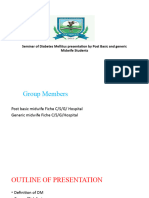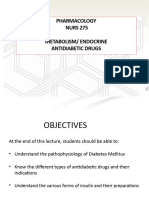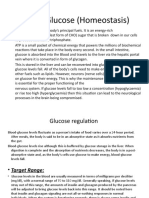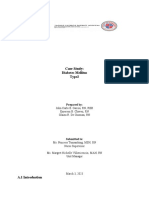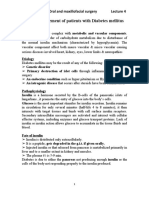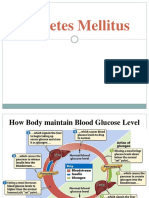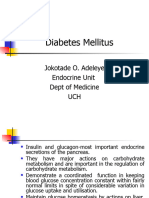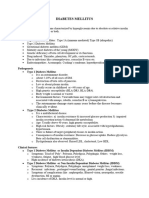0 ratings0% found this document useful (0 votes)
2 views2 Dmpart1
2 Dmpart1
Uploaded by
sameh EidCopyright:
© All Rights Reserved
Available Formats
Download as PDF, TXT or read online from Scribd
2 Dmpart1
2 Dmpart1
Uploaded by
sameh Eid0 ratings0% found this document useful (0 votes)
2 views31 pagesOriginal Title
2 DMPART1
Copyright
© © All Rights Reserved
Available Formats
PDF, TXT or read online from Scribd
Share this document
Did you find this document useful?
Is this content inappropriate?
Copyright:
© All Rights Reserved
Available Formats
Download as PDF, TXT or read online from Scribd
Download as pdf or txt
0 ratings0% found this document useful (0 votes)
2 views31 pages2 Dmpart1
2 Dmpart1
Uploaded by
sameh EidCopyright:
© All Rights Reserved
Available Formats
Download as PDF, TXT or read online from Scribd
Download as pdf or txt
You are on page 1of 31
Zarqa University
Pharmacy school
Clinical Pharmacy Department
Pharmacology II
Drugs for diabetes
Dr. Haneen Basheer
Dr. Shourok Ibrahim
2nd semester 2022.2023
Overview
• The endocrine pancreas in the adult human
consists of approximately 1 million islets of
Langerhans interspersed throughout the
pancreatic gland.
Hormone products include:
• Insulin the storage and anabolic hormone of the body;
• Islet amyloid polypeptide (IAPP, or amylin), which
modulates appetite, gastric
emptying, glucagon and insulin secretion
• Glucagon, the hyperglycemic factor that mobilizes
glycogen stores;
• Somatostatin, a universal inhibitor of secretory cells;
• Pancreatic peptide, a small protein that facilitates
digestive processes by a mechanism not yet clarified;
and ghrelin, a peptide known to increase food intake
Pro-Insulin structure
Insulin secretion
• Insulin is released from pancreatic beta cells at a low
basal rate and at a much higher stimulated rate in
response to a variety of stimuli, especially glucose
• Other stimulants such as other sugars (eg, mannose),
amino acids, hormones such as glucagon-like
polypeptide 1 (GLP-1), glucose-dependent insulinotropic
polypeptide (GIP), glucagon, cholecystokinin, high
concentrations of fatty acids, and β-adrenergic
sympathetic activity are recognized.
• Stimulatory drugs include sulfonylureas, meglitinide
and nateglinide, isoproterenol, and acetylcholine.
Cont
• Inhibitory signals are hormones
including insulin itself, islet amyloid
polypeptide, somatostatin, and leptin; α-
adrenergic sympathetic activity; chronically
elevated glucose; and low concentrations of
fatty acids.
• Inhibitory drugs:
include diazoxide, phenytoin, vinblastine,
and colchicine.
Insulin secretion
Insulin Degradation
• The liver and kidney are the two main organs that
remove insulin from the circulation.
• The liver normally clears the blood of approximately 60% of
the insulin released from the pancreas by virtue of its location
as the terminal site of portal vein blood flow, with the kidney
removing 35–40% of the endogenous hormone.
• However, in insulin-treated diabetics receiving
subcutaneous insulin injections, this ratio is reversed, with as
much as 60% of exogenous insulin being cleared by the kidney
and the liver removing no more than 30–40%.
• The half-life of circulating insulin is 3–5 minutes.
The Insulin Receptor
•kinases are the docking
proteins: insulin recepto
r substrates (IRS)
Cont
• Various hormonal agents (eg, glucocorticoids)
lower the affinity of insulin receptors for insulin;
growth hormone in excess increases this affinity
slightly.
• Aberrant serine and threonine phosphorylation
of the insulin receptor β subunits or IRS
molecules may result in insulin resistance and
functional receptor down-regulation.
Effects of Insulin on Its Targets
Diabetes mellitus
• Is defined as an elevated blood glucose
associated with absent or inadequate
pancreatic insulin secretion, with or without
concurrent impairment of insulin action.
• The disease states underlying the diagnosis of
diabetes mellitus are now classified into four
categories: type 1, type 2, other,
and gestational diabetes mellitus
Types of DM
Type 1 DM (insulin deficient) Type 1 diabetes is further subdivided into
immune-mediated (type 1a) and idiopathic
causes (type 1b)
Insulin therapy is essential
Type 2 DM (insulin resistance combined circulating endogenous insulin is sufficient
with β-cell dysfunction). to prevent ketoacidosis, it is inadequate to
prevent hyperglycemia.
Patients with type 2 diabetes can initially be
controlled with diet, exercise and oral
glucose lowering agents or non-insulin
injectables.
Some patients have progressive beta cell
failure and eventually may also
need insulin therapy.
Gestational diabetes Most women become normoglycemic after
pregnancy; however, 30% to 50% of these
women develop type 2 DM later in life
Other other specific causes of an elevated blood
glucose: pancreatectomy, pancreatitis, non-
pancreatic diseases, drug therapy
Clinical presentation
• Individuals with type 1 DM are often thin and are
prone to ketoacidosis if insulin is withheld or under
conditions of severe physiological stress.
• Symptoms such as polyuria, polydipsia, polyphagia,
weight loss, and lethargy are common at the time of
initial presentation.
• In the outpatient setting, some patients present with
vague complaints of weight loss and fatigue but other
symptoms may not be apparent unless a
comprehensive history is taken.
Cont
• Twenty percent to 40% of patients with type 1
DM present with diabetic ketoacidosis (DKA)
after several days of polyuria, polydipsia,
polyphagia, and weight loss.
DM2
• Patients with type 2 DM often present without
symptoms, but the presence of microvascular
complications at the time of diagnosis suggest that
many patients have had hyperglycemia for years.
• Often patients with type 2 DM are diagnosed during
routine blood testing or screening. Lethargy, polyuria,
nocturia, and polydipsia can be seen at diagnosis in
some patients with type 2 diabetes, but significant
weight loss is less common.
• Most patients with type 2 DM are overweight or obese
Classical signs of DM
Complication of Diabetes
• Acute complications:
– Ketoacidosis (Type 1)
– The hyperglycemic hyperosmolar nonketotic
syndrome(Type 2)
– Hypoglycemia
• Chronic complications:
– Disorders of the microcirculation
• Neuropathies
• Nephropathies
• Retinopathies
– Macrovascular complications
– Foot ulcers
• Hyperglycemia and glycosuria may influence the
growth of microorganisms and increase the severity
of the infection
DKA and HHS
• In DKA, metabolic acidosis is often the major
finding, while the serum glucose
concentration is generally below 800 mg/dL
(44.4 mmol/L) and often approximately 350 to
500 mg/dL (19.4 to 27.8 mmol/L).
• DKA is characterized by ketoacidosis and
hyperglycemia, while HHS usually has more
severe hyperglycemia but no ketoacidosis
DKA and HHS
clinical presntation
• Diabetic ketoacidosis (DKA) usually evolves rapidly, over a
24-hour period. In contrast, symptoms of hyperosmolar
hyperglycemic state (HHS) develop more insidiously with
polyuria, polydipsia, and weight loss, often persisting for
several days before hospital admission.
• The earliest symptoms of marked hyperglycemia are
polyuria, polydipsia, and weight loss. As the degree or
duration of hyperglycemia progresses, neurologic
symptoms, including lethargy, focal signs, and obtundation,
can develop. This can progress to coma in later stages.
Neurologic symptoms are most common in HHS, while
hyperventilation and abdominal pain are primarily limited to
patients with DKA.
Copyrights apply
Treatment Goals of DM
• Reduce risk for microvascular & macrovascular
disease complications
• Ameliorate symptoms
• Prevent acute complications from high blood
glucose levels
• Minimizing hypoglycemic episodes
• Reduce mortality
• Improve quality of life
Glycemic goals
You might also like
- Typhoid Management Guideline 2022-Jun-22 - 221107 - 103145Document15 pagesTyphoid Management Guideline 2022-Jun-22 - 221107 - 103145Shanza AmaanNo ratings yet
- Anti Diabetic DrugsDocument58 pagesAnti Diabetic DrugsDaniel Wang100% (1)
- Nursing Care Plans For Diabetes MellitusDocument12 pagesNursing Care Plans For Diabetes MellitusRaveen mayi85% (59)
- DM Reporting ZDocument52 pagesDM Reporting ZZsazsaNo ratings yet
- Type 2 DMDocument14 pagesType 2 DMraffia mehakNo ratings yet
- ENDO DiabetesDocument9 pagesENDO DiabetesHajime NakaegawaNo ratings yet
- Diabetes MellitusDocument26 pagesDiabetes MellitusKamlesh KishorNo ratings yet
- Paeda DMDocument38 pagesPaeda DMAmanuel LemiNo ratings yet
- DM FinaDocument3 pagesDM FinaChared LumbaNo ratings yet
- Management of Diabetis MellitusDocument24 pagesManagement of Diabetis MellitusTasmia TasnimNo ratings yet
- Management of Diabetes Mellitus 11Document25 pagesManagement of Diabetes Mellitus 11khalid.zainab100% (1)
- HypoglycemiaDocument19 pagesHypoglycemiaJesus PadillaNo ratings yet
- Lec 1Document9 pagesLec 1fbbqbcht6yNo ratings yet
- Nursing Care Plans For Diabetes MellitusDocument12 pagesNursing Care Plans For Diabetes MellitusPuteri AzmanNo ratings yet
- Diabetes MellitusDocument19 pagesDiabetes MellitusHaleelu Abdul JaleelNo ratings yet
- Lecture16 Anti Diabetic DrugsDocument61 pagesLecture16 Anti Diabetic Drugsharis.18No ratings yet
- Module 8 Assessment and Management of Patients With DiabetesDocument44 pagesModule 8 Assessment and Management of Patients With DiabetesBlessed GarcianoNo ratings yet
- anaes&DMDocument11 pagesanaes&DMMohamed Satti AbdalsadigNo ratings yet
- Presentation On Diabetes Mellitus in Pharmacology LabDocument35 pagesPresentation On Diabetes Mellitus in Pharmacology Labpurwo yuhantoNo ratings yet
- Blood Glucose (Homeostasis)Document17 pagesBlood Glucose (Homeostasis)areebaNo ratings yet
- Hypoglycemia and HyperglycemiaDocument24 pagesHypoglycemia and HyperglycemiaNarayan GhimireNo ratings yet
- Pathophysiology of DMDocument45 pagesPathophysiology of DMAmanuel MaruNo ratings yet
- CertainlygggDocument3 pagesCertainlygggavidadarkestevilNo ratings yet
- Diabetes 2nd PartDocument14 pagesDiabetes 2nd PartAdnan RAHATNo ratings yet
- Diabetes Mellitus Type2: Case StudyDocument48 pagesDiabetes Mellitus Type2: Case StudyJohn Carlo GarciaNo ratings yet
- 222 Diabetes 2Document61 pages222 Diabetes 2Rahman Md.MoshiurNo ratings yet
- DiabetesDocument49 pagesDiabetesAiswarya MishraNo ratings yet
- TM DiabetesDocument3 pagesTM Diabetesdian dayanaNo ratings yet
- TM DiabetesDocument3 pagesTM DiabetesJulia SetiawatiNo ratings yet
- Diabetes MellitusDocument18 pagesDiabetes MellitusAadhan ArveeNo ratings yet
- Diabetes Mellitus.U.iiDocument38 pagesDiabetes Mellitus.U.iitamtamtamtama0No ratings yet
- Diabetes Mellitus: TypesDocument4 pagesDiabetes Mellitus: TypesMohammed SayedNo ratings yet
- Dental Management of Patients With Diabetes MellitusDocument8 pagesDental Management of Patients With Diabetes Mellitusاحمد سلامNo ratings yet
- Physiology and Causes of DiabatesDocument7 pagesPhysiology and Causes of DiabatesasaadsarfrazNo ratings yet
- Insulin and HypoglycemiaDocument39 pagesInsulin and Hypoglycemiao30285619No ratings yet
- Diabetes Mellitus 2021Document61 pagesDiabetes Mellitus 2021Andarge ImperialNo ratings yet
- Diabetes Mellitus - 2022-2023 - First Semester - DownloadDocument97 pagesDiabetes Mellitus - 2022-2023 - First Semester - DownloadLeoNo ratings yet
- Welcome To The PresentationDocument32 pagesWelcome To The PresentationIshaan Arfatur Rahman0% (1)
- Diabetes Millitus PDFDocument41 pagesDiabetes Millitus PDFAbdullah BhattiNo ratings yet
- Diabetes and It's Oral ManifestationsDocument28 pagesDiabetes and It's Oral ManifestationsYashpreetsingh BhatiaNo ratings yet
- Diabetes Mellitus (DM) : ContentDocument30 pagesDiabetes Mellitus (DM) : ContentMompati LetsweletseNo ratings yet
- Hand Out DM Medical Surgical Nursing 2Document11 pagesHand Out DM Medical Surgical Nursing 2Zarlou OtamiasNo ratings yet
- Diabetes MellitusDocument20 pagesDiabetes MellitusNidhi shriNo ratings yet
- 4,5 - Diabetes MellitusDocument22 pages4,5 - Diabetes MellitusA A D H INo ratings yet
- 6 Intro To DMDocument38 pages6 Intro To DMSPUB HPONTIANNo ratings yet
- Disorder of Carbohydrate Metabolism-1Document47 pagesDisorder of Carbohydrate Metabolism-1Anggun s longgiNo ratings yet
- 1.CHAPTER 1 What Is DiabetesDocument7 pages1.CHAPTER 1 What Is DiabetesGautam ManoharNo ratings yet
- E SystemDocument81 pagesE SystemErsido SamuelNo ratings yet
- Diabetes MellitusDocument24 pagesDiabetes MellitusIgwe SolomonNo ratings yet
- Bhs InggrisDocument13 pagesBhs Inggrisciko sisca bintang pamungkhasNo ratings yet
- Metabolic Disorders Diabetes HandoutDocument21 pagesMetabolic Disorders Diabetes HandoutEdelen GaleNo ratings yet
- DIABETES MELLITUS - DR Neelakanta KaradkalDocument45 pagesDIABETES MELLITUS - DR Neelakanta KaradkalNRK A OFFICIALNo ratings yet
- Diabetes MellitusDocument30 pagesDiabetes Mellitusurusha vaidyaNo ratings yet
- 9 - Assessment and Management of Patients With Diabetes MellitusDocument60 pages9 - Assessment and Management of Patients With Diabetes Mellitussohaib salamehNo ratings yet
- Diabetes Mellitus 2Document8 pagesDiabetes Mellitus 2devanshipadh9No ratings yet
- Chronic Disease DiabetesDocument47 pagesChronic Disease DiabetesAries CruzNo ratings yet
- Diabetes Mellitus NewDocument97 pagesDiabetes Mellitus NewTMC PGI GENER MICKONo ratings yet
- Diabetes Mellitus - SlidesDocument28 pagesDiabetes Mellitus - SlidesReem ShamasNo ratings yet
- 4,5 - Diabetes Mellitus..by UroojDocument19 pages4,5 - Diabetes Mellitus..by Urooj26-Talha ShahNo ratings yet
- Diabetes Mellitus Is A Group of Metabolic Diseases Characterized byDocument67 pagesDiabetes Mellitus Is A Group of Metabolic Diseases Characterized byBivek TimalsinaNo ratings yet
- Breaking the Chains of Diabetes. A Comprehensive Guide to Understanding and Managing Diabetes NaturallyFrom EverandBreaking the Chains of Diabetes. A Comprehensive Guide to Understanding and Managing Diabetes NaturallyNo ratings yet
- 2023.2024chronic Obstructive Pulmonary DiseaseDocument17 pages2023.2024chronic Obstructive Pulmonary Diseasesameh EidNo ratings yet
- Lower Respiratory Tract Infection - CAP: Therapy II - LabDocument14 pagesLower Respiratory Tract Infection - CAP: Therapy II - Labsameh EidNo ratings yet
- Acute Otitis Media 2023.2024Document19 pagesAcute Otitis Media 2023.2024sameh EidNo ratings yet
- 2 Copd 2023.2024.Document4 pages2 Copd 2023.2024.sameh EidNo ratings yet
- Lung Center of The Philippines: Advantages of 3 and 6 Gene Panel The MDCTL FacilitiesDocument2 pagesLung Center of The Philippines: Advantages of 3 and 6 Gene Panel The MDCTL FacilitiesYannah ReonalNo ratings yet
- EndocrineDocument49 pagesEndocrineApsaraNo ratings yet
- TLCR 20 635 Author Proof1Document17 pagesTLCR 20 635 Author Proof129milce17No ratings yet
- New Starter DetailsDocument7 pagesNew Starter DetailsalexandrudstroeNo ratings yet
- Comparison Between DOAC To Enoxaparin For Risk of Intracranial BleedingDocument2 pagesComparison Between DOAC To Enoxaparin For Risk of Intracranial BleedingFathima Sheik KatherNo ratings yet
- Day 4 L2Document90 pagesDay 4 L2yousif.05001467No ratings yet
- Summative Test in Pe HealthDocument1 pageSummative Test in Pe HealthRandy ballermoNo ratings yet
- Physical Fitness RRLDocument5 pagesPhysical Fitness RRLShaina AbbasNo ratings yet
- Final TopicDocument5 pagesFinal TopicL.A L.ANo ratings yet
- Fluid Volume Deficit Related To Nausea and VomitDocument3 pagesFluid Volume Deficit Related To Nausea and VomitJakeNo ratings yet
- Cold & Decrease Pain For Circulation - WarmDocument3 pagesCold & Decrease Pain For Circulation - Warmmyer pasandalanNo ratings yet
- Nurs FPX 4030 Assessment 3 Pico T Questions and An Evidence Based ApproachDocument5 pagesNurs FPX 4030 Assessment 3 Pico T Questions and An Evidence Based Approachlilykevin075No ratings yet
- Transes 1 (PEDIATRICS-LAB)Document2 pagesTranses 1 (PEDIATRICS-LAB)Ashley Judd EmpaynadoNo ratings yet
- Chapter 14 - Hypersensitivity - Review QuestionsDocument2 pagesChapter 14 - Hypersensitivity - Review QuestionsTreyton Sekani LopezNo ratings yet
- 746268KU Rehab Question PaperDocument22 pages746268KU Rehab Question PaperSANJAY SNo ratings yet
- Wound Dehiscence Burst Abdomen: by R.V.Kalyani Gen Surgery V UnitDocument25 pagesWound Dehiscence Burst Abdomen: by R.V.Kalyani Gen Surgery V Unitvinitha kattaNo ratings yet
- CD PresentationDocument225 pagesCD PresentationHersy Marie Azores GarayNo ratings yet
- Test Bank For Maternity and Womens Health Care 11th Edition by LowdermilkDocument11 pagesTest Bank For Maternity and Womens Health Care 11th Edition by Lowdermilkdonnadaviskjqpxitacn100% (37)
- BMJ 2020 063439.fullDocument15 pagesBMJ 2020 063439.fullMonika Diaz KristyanindaNo ratings yet
- CI TPT ImplementationGuide - 08oct2021Document44 pagesCI TPT ImplementationGuide - 08oct2021aika rosalesNo ratings yet
- TJPT 4y2s NursemDocument121 pagesTJPT 4y2s NursemJohnmichael MacaraegNo ratings yet
- Hemorrhoids, ParaproctitisDocument56 pagesHemorrhoids, ParaproctitisСандагсүрэн СандагдоржNo ratings yet
- 2457-Article Text-14907-2-10-20120724Document6 pages2457-Article Text-14907-2-10-20120724desi meleniaNo ratings yet
- AIDSDocument8 pagesAIDSpreetheeshNo ratings yet
- Uas BHS Inggris DLM Praktik KebidananDocument8 pagesUas BHS Inggris DLM Praktik Kebidananayu kartini deviNo ratings yet
- Cognitive DisordersDocument67 pagesCognitive DisordersSIMRAN GIDWANI 2238961No ratings yet
- Nathanael Lassiter - U1l6 - Jigsaw ActivityDocument3 pagesNathanael Lassiter - U1l6 - Jigsaw Activityapi-551922465No ratings yet
- PacemakerDocument24 pagesPacemakerLAWKUSH KUMARNo ratings yet
- A Case Study On The Clinical Management of Cow Lumpy Skin Disease Using Homeopathic Remedies.Document3 pagesA Case Study On The Clinical Management of Cow Lumpy Skin Disease Using Homeopathic Remedies.Jibachha SahNo ratings yet







